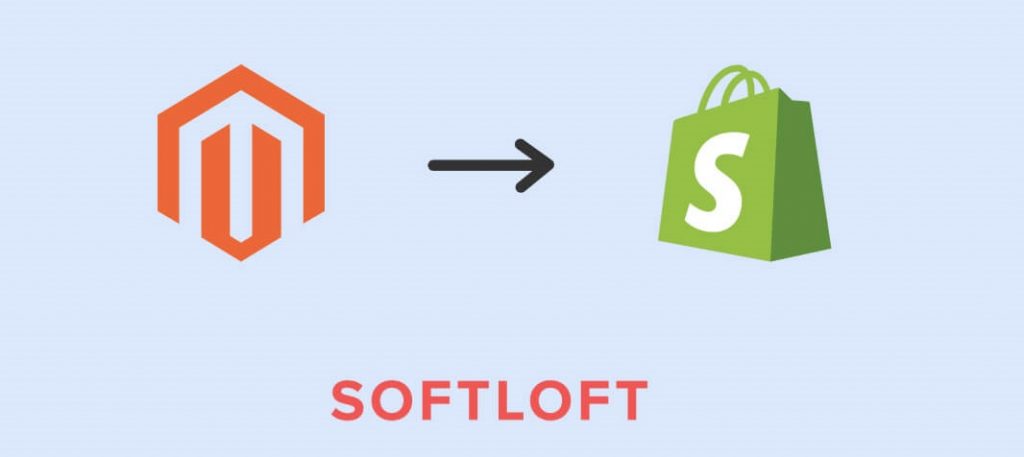Migration from Magento to Shopify looks like migrating the entire house from one location to another. Sometimes, it is a very desired and even necessary thing. Though, moving the entire house is a huge deal because it needs thorough preparation and large commitment from all members of the migration process. If you need to migrate your eCommerce project from Magento to Shopify, the best move to decide on is to contract professionals. Of course, you can do everything yourself but contracting SoftLoft for the deal is going to save you tons of time.

Why Migrate to Shopify
Anyway, whether you decide to do a migration yourself or you want to contact professional help, you will want to know a few things. First, migration to Shopify is going to be a nice move if you are running an online store. Shopify was initially developed to help entrepreneurs to build and manage their online stores. So, ideally, the process of migration and consequent business processes are going to be simple.
However, the benefits of migrating to Shopify are multiple. First, after investing in migration, you are going to get an online store that needs minimal effort and minimal time for support and maintenance. That said, when the online store is running on Shopify, minimal developer support is necessary. Practically, this means lower maintenance costs and therefore comparatively cheaper prices on the market. Eventually, this might become a part of the cost-effective market strategy.
Read also: Benefits for eCommerce of PIM Software
Moreover, migration to Shopify helps to make sure about the security and hosting infrastructure, and benefit from a variety of add-ons, apps, and features. In other words, migration to Shopify is an investment in the development of an online business that is priceless from the point of view of the development perspective. So, basically, the answer to the question Why Migrate to Shopify is going to be “to reduce maintenance costs for the online store while providing interesting features for customers.”
Challenges of Migration from Magento to Shopify
When the decision to migrate has already been made, it is time to be prepared for the migration process and be ready to beat the challenges. Practically, like with any migration process, migrating the online store from Magento to Shopify requires considerable effort. First of all, there is a need to review the way that the store operates today so that only necessary well-working structures are migrated. Overall, Shopify has three plans and extensive round-the-clock support, which means that if any questions need to be solved, Shopify is going to fix them asap.
In addition to preparing for the migration process, there is a need to make sure that all necessary data are migrated. In the process of migration, you will need to make sure that all necessary content and data are moved, and this is practically the biggest challenge whatsoever. When we move a house, we need to make sure it is not going to be broken and nothing is lost. The same thing applies to the store. The biggest challenges are revising the existing data and structure and moving the data.
Seven Steps to Migrate from Magento to Shopify
There are seven main steps to migrate the online store from Magento to Shopify that include but are not limited to setting up a Shopify account, creating a backup for the case something goes wrong, download the Store Import App, export data from Magento, and import data to Shopify, review imported data and design your new Shopify store.
-
Set Up a Shopify Account
When setting up the account, choose one of the pricing plans, The main pricing plans are:
- Basic Shopify ($29/month)
- Shopify ($79/month)
- Advanced Shopify ($299/month)
With Shopify $79 monthly you get social selling and fast and reliable check out. The main difference between Basic and Shopify is the number of staff accounts available. Of course, with Advanced you are going to get the most of Shopify, but this solution is pricey.
-
Make a Backup Copy of Your Magento Store
For this step, prepare the backup of your store, using Magento Admin sidebar, specifically ‘System’ >‘Tools’ >‘Backups’.the Admin sidebar, then ‘System’ >‘Tools’ >‘Backups’. It's true that your hosting provider might make backups but better safe than sorry anyway.
-
Download Shopify App
After backup is ready, download and install the Shopify App and login with your subscription. Thus, you will get signed into your account and your admin panel. Thus, simply click ‘Apps’ then ‘Import Store’. Afterward, follow the instructions, and you will get your store imported.
-
Add Your Content
When you have your admin panel set up, click ‘System’ on the Admin sidebar, then ‘Data Transfer’ > ‘Export’. Then, just follow the instructions and you'll get your store set. Ideally, you are going to get the structure of your store imported to Shopify.
-
Import Your Store Data
Now the process is almost done. Visit the Shopify admin page then click ‘Apps’ > ‘Import Store’. Afterward, select Magento from the drop-down menu, and click 'Add file' under ‘ Upload Files’. Then, select the files to import. Finally, select the Magento file that you downloaded and click ‘Continue import’.
-
Review Your Imported Data
Make sure to check the product descriptions and alt tags for pictures so that search engines can index your store. In addition, the rest data should be checked for fullness and correctness too. That said, all the product descriptions, titles, and pictures are better to be checked as soon as migrated to avoid losing customers because of the inadequate design and improper product descriptions.
-
Design Your Store
Finally, just customize Shopify up to your taste. This might mean editing menus and product displays, checking categories, etc. Any kind of customization that makes your store look unique is going to be helpful to attract more customers.
Help Is Here
Thus, the process of migrating the store is not easy. Truly, it is more effective to delegate migration from Magento to Shopify to qualified people. Anyway, it's up to you to decide, just remember that the help of SoftLoft is just a phone call away.



